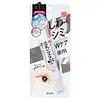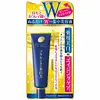What's inside
What's inside
 Key Ingredients
Key Ingredients

 Benefits
Benefits

 Concerns
Concerns

 Ingredients Side-by-side
Ingredients Side-by-side

Niacinamide
SmoothingWater
Skin ConditioningButylene Glycol
HumectantSqualane
EmollientGlycerin
HumectantGlyceryl Ethylhexanoate
EmollientBatyl Alcohol
EmollientHydrogenated Egg Oil
Skin ConditioningGlyceryl Stearate Se
EmulsifyingStearic Acid
CleansingDipentaerythrityl Hexa C5-9 Acid Esters
Skin ConditioningPEG-8 Dimethicone
EmulsifyingMilk Ferment
Skin ConditioningRetinol
Skin ConditioningN-Stearoyl-Dihydrosphingosine
Skin ConditioningPullulan
Cyclodextrin
AbsorbentAlcohol Denat.
AntimicrobialPolyvinylalcohol Crosspolymer
Glycosyl Trehalose
Emulsion StabilisingGlycine Soja Extract
Skin ConditioningCetyl Palmitate
EmollientHydroxyethylcellulose
Emulsion StabilisingPhytosterols
Skin ConditioningBehenyl Alcohol
EmollientPolysorbate 20
EmulsifyingPotassium Hydroxide
BufferingSodium Hydroxide
BufferingHydrogenated Phosphatidylcholine
EmulsifyingPhenoxyethanol
PreservativeNiacinamide, Water, Butylene Glycol, Squalane, Glycerin, Glyceryl Ethylhexanoate, Batyl Alcohol, Hydrogenated Egg Oil, Glyceryl Stearate Se, Stearic Acid, Dipentaerythrityl Hexa C5-9 Acid Esters, PEG-8 Dimethicone, Milk Ferment, Retinol, N-Stearoyl-Dihydrosphingosine, Pullulan, Cyclodextrin, Alcohol Denat., Polyvinylalcohol Crosspolymer, Glycosyl Trehalose, Glycine Soja Extract, Cetyl Palmitate, Hydroxyethylcellulose, Phytosterols, Behenyl Alcohol, Polysorbate 20, Potassium Hydroxide, Sodium Hydroxide, Hydrogenated Phosphatidylcholine, Phenoxyethanol
Placental Extract
Tocopheryl Acetate
AntioxidantCollagen
MoisturisingTripeptide-8
Skin ConditioningCoix Lacryma-Jobi Ma-Yuen Seed Extract
Skin ConditioningDiospyros Kaki Fruit Extract
Skin ConditioningPCA
HumectantAluminum Acetate Solution
AstringentMalic Acid
BufferingOryza Sativa Bran Oil
EmollientGlycosphingolipids
EmollientPhospholipids
Skin ConditioningTocopherol
AntioxidantHydroxyproline
Skin ConditioningGlycerin
HumectantButylene Glycol
Humectant1,5-Pentanediol
SolventPolyglyceryl-2 Oleate
EmulsifyingGlyceryl Stearate
EmollientPolyglyceryl-5 Stearate
EmulsifyingEthylhexyl Palmitate
EmollientBeeswax
Emulsion StabilisingDimethicone
EmollientStearic Acid
CleansingCaprylyl Alcohol
MaskingPolypentaerythrityl C5-10 Acid Esters
Hydrogenated Polybutene
Behenyl Alcohol
EmollientC4-18 Alkyl Methacrylate/Methacryloyloxyethyl Phosphorylcholine Copolymer
HumectantAlcohol Denat.
AntimicrobialPhenoxyethanol
PreservativeSodium Paraben
PreservativeParfum
MaskingPlacental Extract, Tocopheryl Acetate, Collagen, Tripeptide-8, Coix Lacryma-Jobi Ma-Yuen Seed Extract, Diospyros Kaki Fruit Extract, PCA, Aluminum Acetate Solution, Malic Acid, Oryza Sativa Bran Oil, Glycosphingolipids, Phospholipids, Tocopherol, Hydroxyproline, Glycerin, Butylene Glycol, 1,5-Pentanediol, Polyglyceryl-2 Oleate, Glyceryl Stearate, Polyglyceryl-5 Stearate, Ethylhexyl Palmitate, Beeswax, Dimethicone, Stearic Acid, Caprylyl Alcohol, Polypentaerythrityl C5-10 Acid Esters, Hydrogenated Polybutene, Behenyl Alcohol, C4-18 Alkyl Methacrylate/Methacryloyloxyethyl Phosphorylcholine Copolymer, Alcohol Denat., Phenoxyethanol, Sodium Paraben, Parfum
 Reviews
Reviews

Ingredients Explained
These ingredients are found in both products.
Ingredients higher up in an ingredient list are typically present in a larger amount.
Alcohol Denat. is an alcohol with a denaturant property. It is created by mixing ethanol with other additives.
This ingredient gets a bad rep because it is irritating and drying - mostly due to its astringent property. Astringents draw out natural oils in tissue, constricting pores and leaving your skin dried out.
However, alcohol denat. is not all that bad.
Due to its low molecular weight, alcohol denat. tends to evaporate quickly. One study on pig skin found half of applied alcohol evaporated in 10 seconds and less than 3% stayed on skin.
This also helps other ingredients become better absorbed upon application.
Studies are conflicted about whether this ingredient causes skin dehydration. One study from 2005 found adding emollients to propanol-based sanitizer decreased skin dryness and irritation. Another study found irritation only occurs if your skin is already damaged.
Small amounts of alcohol are generally tolerated by oily skin or people who live in humid environments.
The rule of thumb is if this alcohol is near the end of an ingredients list, it will probably not affect your skin much.
Also...
This ingredient has antimicrobial and solvent properties.
The antimicrobial property helps preserve products and increase their shelf life. As a solvent, it helps dissolve other ingredients.
Other types of astringent alcohols include:
Learn more about Alcohol Denat.Behenyl Alcohol is a type of fatty alcohol (these are different from the drying, solvent alcohols).
Fatty Alcohols have hydrating properties and are most often used as an emollient or to thicken a product. They are usually derived from natural fats and oils; behenyl alcohol is derived from the fats of vegetable oils.
Emollients help keep your skin soft and hydrated by creating a film that traps moisture in.
In 2000, Behenyl Alcohol was approved by the US as medicine to reduce the duration of cold sores.
Learn more about Behenyl AlcoholButylene Glycol (or BG) is used within cosmetic products for a few different reasons:
Overall, Butylene Glycol is a safe and well-rounded ingredient that works well with other ingredients.
Though this ingredient works well with most skin types, some people with sensitive skin may experience a reaction such as allergic rashes, closed comedones, or itchiness.
Learn more about Butylene GlycolGlycerin is already naturally found in your skin. It helps moisturize and protect your skin.
A study from 2016 found glycerin to be more effective as a humectant than AHAs and hyaluronic acid.
As a humectant, it helps the skin stay hydrated by pulling moisture to your skin. The low molecular weight of glycerin allows it to pull moisture into the deeper layers of your skin.
Hydrated skin improves your skin barrier; Your skin barrier helps protect against irritants and bacteria.
Glycerin has also been found to have antimicrobial and antiviral properties. Due to these properties, glycerin is often used in wound and burn treatments.
In cosmetics, glycerin is usually derived from plants such as soybean or palm. However, it can also be sourced from animals, such as tallow or animal fat.
This ingredient is organic, colorless, odorless, and non-toxic.
Glycerin is the name for this ingredient in American English. British English uses Glycerol/Glycerine.
Learn more about GlycerinPhenoxyethanol is a preservative that has germicide, antimicrobial, and aromatic properties. Studies show that phenoxyethanol can prevent microbial growth. By itself, it has a scent that is similar to that of a rose.
It's often used in formulations along with Caprylyl Glycol to preserve the shelf life of products.
Stearic Acid is a fatty acid. It is an emollient, emulsifier, and texture enhancer.
As an emollient, stearic acid helps soften skin. It aids the skin's protective barrier by preventing water loss. It also provides a gentle cleansing effect without stripping away natural oils.
Stearic acid may also be used to enhance the texture of products. It can add volume and stabilize ingredients such as water and oil. This can help water and oil ingredients from separating.
Sources of stearic acid include animal or vegetable fats/oils such as coconut or shea. It can be naturally found in butter, cocoa butter, shea butter, vegetable fats, and animal tallow.
This ingredient may not be Malassezia folliculitis, or fungal-acne safe.
Learn more about Stearic Acid